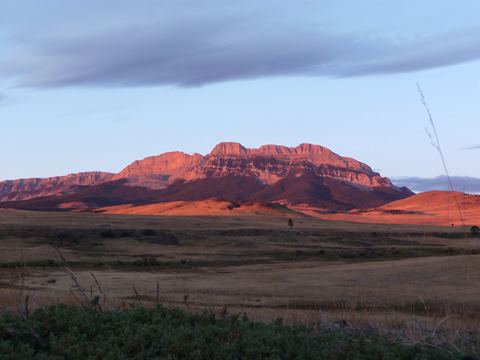Thanks to Matthew Koehler for this submission..
As a federal prosecutor in Eugene I oversaw in the late 1980s and early 1990s a dozen investigations and prosecutions exposing rampant theft of federal timber. These thefts ran into the tens of millions of dollars and mocked thousands of hours of scientific work that established federal timber sale boundaries.
I saw partial- and select-cut sales metamorphose into logged clear-cuts. I saw sale boundaries breached by acres. I saw off-limits streams desecrated by heavy equipment. I saw wildlife migration preserves sliced and diced.
I later oversaw investigations that made these crude but massive multi-million dollar thefts look like piker play when hundreds of millions of dollars in perfectly merchantable federal timber removed from these sales was scaled as defective by so-called independent scaling bureaus hired by the timber companies.
By far the most disturbing aspect of all this was the ease with which these crimes were perpetrated while the government’s flawed monitoring systems were systematically compromised.
I came from Chicago, where I prosecuted public corruption cases involving every imaginable type of venality. Based upon my experience, I naturally assumed that government officials had been paid off to ignore theft and fraud on federal timber sales. Only after extensive grand jury investigations in numerous cases over many years did I conclude that the corruption was primarily cultural rather than monetary.
When I arrived in Oregon in the mid-1980s in the middle of the forest wars, I believed that poor Smokey Bear was trapped in a hellacious battle between rabid environmentalists and greedy timber companies and was doing the best he could to balance competing interests in his ham-handed paws. A decade later I became convinced to my core that Smokey was a tamed denizen of industry.
How did this happen? The Gulf oil spill, defense contracting scandals, the current financial crisis, and numerous other scandals that have bridged generations lead to an inescapable conclusion: The regulatory agencies of government have been co-opted by industry.
All such regulatory problems germinate at the campaign contribution stage, mushrooming into a pervasive culture that serves profit-driven corporations to the detriment of Joe Citizen. Powerful industries help to finance our elected officials’ political campaigns. This system of legalized bribery has been legitimized by illogical court rulings that campaign contributions are “free speech” and other legal fictions that ignore the reality of a government for sale. In return donors from regulated industries fully expect the regulatory agencies to be made well aware of industry’s expectations and demands.
Regulatory dereliction manifests itself in government timber sales in many ways. Standard timber sale contracts overwhelmingly benefit the industry, typically leading to net taxpayer losses on timber sales after the public has paid for logging roads and other costs. Contractual breaches often result in additional company profits rather than penalties when the fines for taking timber illegally are far below the price paid by the mills for illicitly cut timber. Clear-cuts approved by the Forest Service destroy forest diversity but make it less expensive for timber companies to log sites. I observed these and many other flaws over the course of 10 maddening years.
My first major case of systematic theft was never reported by the Forest Service, but was discovered when members of a Sisters environmental group hiked through a grove of old-growth Ponderosa pine that they had been instrumental in sparing — only to discover that this magnificent stand had been clear-cut by the logging company, even though paint clearly marked the base of the trees that were to be left. Only the vocal complaints of this small group led to law enforcement investigating an apparent criminal act.
When Forest Service law enforcement agents and forest forensics specialists inspected hundreds of units of many timber sales logged over many years by this company, they discovered systematic expansion of boundaries and removal of reserve trees — obvious breaches that were never reported by any of the numerous timber sale administrators charged with inspecting these sales.
How could this be? The search for an answer was initially baffling. My Chicago background caused me to search for payoffs, but after years of investigations, including months of grand jury sessions and thousands of law enforcement interviews, I never found bribes paid to Forest Service officials in the grand Chicago tradition. The answer proved to be much more complex and ultimately institutional and cultural.
This culture originated in the political sphere with campaign contributions and eventually permeated the entire regulatory agency. Timber sale administrators learned early in their careers that tough regulatory stances were routinely trumped by supervisors responding to industry complaints. These low-level administrators soon realized that it would be easier to get along than to fight such a formidable foe. They learned that any inappropriate logging of reserve trees was presumed to be a result of mistakes, and never willful criminal acts. They also learned early that potential crimes were not to be reported to law enforcement without explicit supervisor approval, which seemed to never come.
High-ranking Forest Service supervisors routinely referred to the timber industry as their “partner” rather than as companies doing commercial business with the government. This terminology betrayed naiveté and carried a strong suggestion of a political rather than a regulatory choice of words.
Following widespread media coverage of the failure of the Forest Service to prevent these massive timber thefts, congressional hearings were conducted to examine the regulatory flaws that made theft so easy. Predictably, the Forest Service vowed to re-examine and tighten its security systems.
In the wake of these embarrassing revelations a Timber Theft Task Force made up of agency law enforcement agents and trustworthy other agency personnel was formed.
As time passed, it became clear to me that all of this was little more than posturing to allay media criticism. I had seen this same drama play out many times in Chicago. Business as usual continued as soon as the political storm passed.
If anything, some Forest Service managers became even more intransigent with law enforcement, even ordering its agents not to share reports of potential timber theft with the meddlesome federal prosecutor in Eugene. These forest supervisors viewed the congressional and industry mandate to “get the cut out” as far more important than making sure that the cutting was lawful.
At great risk to their careers, some Forest Service personnel followed their higher authority — the pursuit of the truth — and reported both the investigative findings and the potential obstruction to the prosecutor’s office.
These and other incidents nationally led to yet another set of congressional hearings questioning whether Forest Service management was interfering with legitimate criminal investigations into potential timber theft. After these hearings, where the Oregon U.S. attorney himself testified about a long history of such problems, there was in fact some substantive reform — laws requiring that the Forest Service law enforcement function be independent from timber management.
The establishment of the Timber Theft Task Force led to an even more significant investigation. One sliver of the national forest near Salem, the North Santiam Canyon, was intensely scrutinized in a far-ranging grand jury investigation and prosecution. Statistical analyses revealed that over decades major companies in that area were reporting through log scalers — hired by the companies with the endorsement of the Forest Service — 30 percent less merchantable timber than Forest Service timber cruisers concluded was present in the timber sale sites. The companies were not required to pay for the timber that was scaled as defective.
The statistical analyses indicated that just one log scaler with his pencil cheated Joe Taxpayer out of $1 million a year for 20 years, to the benefit of three companies in the North Santiam Canyon.
How could any law-abiding company compete against this triad of illicit profiteers? It was not only the taxpayer coffers being plundered: honest companies were also being forced out of business in that area.
If one scaler could inflict that much damage in one sliver of the massive national forest system, the inherently conflicted scaling system — in which scalers are indebted for their very jobs to the company that hired them — may well have pilfered hundreds of millions of dollars from the taxpayers over the years.
A recurrent topic at multiple congressional hearings in the late 1980s and early 1990s was the dubious ability of the widely used scaling system to honestly determine defects in timber. Time and again Congress recommended that the scaling system be abolished in favor of a system of lump sum sales, where timber companies would make bids based upon their own estimates of defect in a sale site, which would set the price of the timber sale.
Industry officials, in meetings with Forest Service management, strongly opposed the lump sum sale system widely used by the Bureau of Land Management without problems or controversy. To my knowledge the vulnerable conflict-riddled scaling system remains operational in Forest Service timber sales, contrary to repeated congressional recommendations.
During this period I was invited to speak to Forest Service employees around the country regarding the flaws exposed in these prosecutions and investigations. What remains most vivid to me after years of these embarrassing revelations was the continuing resistance of Forest Service management to reporting potential timber theft or scaling fraud to law enforcement officials — because in their opinion it was almost certainly an innocent error.
The recalcitrant culture remained undaunted. In fact, things began to go backwards. The Timber Theft Task Force was summarily abolished for no apparent reason other than potential pressure from Forest Service management and industry. Those brave members who participated were retaliated against in a variety of transparent ways, including undesirable reassignments requiring relocation and being given new duties unrelated to timber theft or scaling fraud.
Predictably, timber theft and timber fraud reports, investigations, and prosecutions dried up despite there being little reason to believe that the system had been systematically improved.
Frustrated, disgusted and burned out by this quixotic effort to change the unchangeable, I asked to be reassigned to other federal cases. For 100 years it was said that “Chicago ain’t ready for reform.” I found the Forest Service comparably resistant.
As the forest wars heat up yet again in a flagging economy and in the midst of massive cuts in government services, recent proposals have included:
Ceding large tracts of public lands to the timber industry.
Suspending environmental laws on certain federal and state lands.
Intensifying the timber harvest on federal and state lands.
Allowing the collection of “biomass” on vast swaths of federal lands.
These and other proposals ignore other potential sources of revenue that are mystifyingly off the table. Corporations with massive timberlands been granted exemptions from state and local property and extraction taxes. These same timber companies have been given unlimited rights to export raw logs from their private lands (and with them thousands of local mill jobs), which then puts additional pressure on our public lands to provide logs to local mills. How can these exemptions, which deprive local and state governments of millions of dollars, be explained as anything other than political payback by misnamed public officials?
Timber companies also enjoy the right to clear-cut public forests when such methods turn diverse forests into pockmarked tree farms, along with the cutting for decades from public lands volumes of timber that far exceeded a sustainable and lawful yield.
These exemptions, actions, and decisions, clearly contrary to the public interest, can only be explained by the extreme bias created by the culture of campaign contributions and fear of reprisal created by the powerful special interest known as the timber industry. In such a climate it would require politicians and bureaucrats to be uncharacteristically courageous in confronting and reversing these policies.
While I believe that most people in both the timber industry and the Forest Service are basically honest, the widespread failure of members of the industry to report theft and fraud and the chronic failure of Forest Service employees to detect and report obvious theft and fraud remain disturbing to me. It was a constant frustration to encounter sworn statements by industry employees denying any knowledge of rampant theft and fraud in their midst. This implausible deniability caused me to conclude after many years that, as was true in the Forest Service, there existed a culture that discouraged such reports.
How can the citizens who own these forests and their local governments now clamoring for timber sale proceeds be protected from theft and fraud and decades of tax-exemption favoritism? Will politicians be willing and able to act only in the public interest, as their oath of office demands? Will the Forest Service be able and willing to devise and implement systems that are effective against fraud and theft, honoring its obligations to the citizenry?
In short, can the culture be changed?
I frankly doubt it. The system of elections supported by campaign contributions, now made unlimited under recent irrational U.S. Supreme Court decisions, poisons the entire political and regulatory system. Whether the industry is oil, finance, defense, or timber, all decisions inevitably favor industry, typically at the expense of the public interest.
The only remedy, in my opinion, is a constitutional amendment that nullifies the Supreme Court opinions and mandates publicly financed campaigns so that politicians’ and bureaucrats’ obligations and loyalties are no longer compromised by campaign contributions from special interests. Unfortunately, the path to such a solution is clogged by the very politicians who are already indebted to their campaign contributors.
However, a broad coalition of arch-conservatives (tea partiers, libertarians, etc.), ultra-liberals (Occupy Wall Street, etc.) and right-thinking independents, Democrats and Republicans already overwhelmingly agree that money and democracy do not mix.
The politicians, many of whom dislike the necessary evil of fundraising, would eventually be forced by a wave of bipartisan and cross-cultural forces to support such an amendment and begin working full time and free of financial conflicts on the nation’s critical issues.
Who knows? Maybe the regulatory agencies such as the Forest Service will eventually change as the residual culture of bias wanes.
Quixotic? A pipe dream? So were the origins of our democracy in 1776. It is time for a re-revolution that restores our form of government to the one envisioned by our founders, where true democracy for real people thrives once again with a capitalism energized by hard work, great ideas and, most importantly, a level field created by honesty and fairness.









